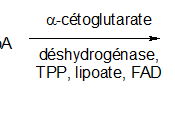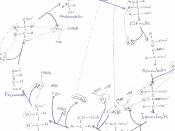Cellular respiration is a metabolic process that occurs in the mitochondria of eukaryotic cells. Respiration is the opposite of photosynthesis, which uses energy from light to create glucose molecules. Respiration catabolizes glucose to produce ATP, the energy molecule used to power most cellular functions. The general equation for respiration is C6H12O6 + 6O2 -> 6CO2 + 6H2O + energy. If respiration occurs in the presence of oxygen it is aerobic respiration. Aerobic respiration consists of three processes: glycolysis, the Krebs cycle, and oxidative phosphorylation. When all three processes are complete a net of 36 ATP will be produced.
The first component of aerobic respiration is glycolysis, which means "splitting of sugar" and it does just what it says. In the process of glycolysis, glucose is broken down to form pyruvate. Nine products are formed and catalyzed by glycolysis before glucose is changed into pyruvate. When the process of glycolysis is finished it produces two pyruvate, two NADH and four ATP.
The second component is the Krebs cycle. The Krebs cycle really finishes the job that glycolysis started. Glycolysis doesn't break down glucose very efficiently, most of the energy is stored in the pyruvate molecules. The Krebs cycle, like glycolysis, contains many steps and produces many products before it produces its end products of NADH and FADH2. The Krebs cycle also produces the CO2 that animals exhale.
The last component of aerobic respiration is oxidative phosphorylation. This process yields the most usable energy for the cell. The electrons from NADH and FADH2 move down an electron transport chain and the energy lost by the electrons is used to phosphorylate ADP to ATP.



Lacking
Well presented and accurate, though lacking in details. Overall a decent job.
4 out of 4 people found this comment useful.